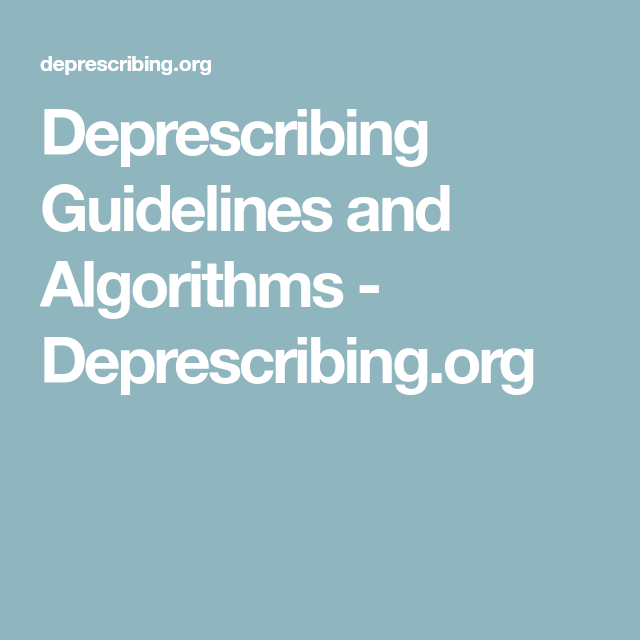Dr. Lee Meyer, PharmD, BCGP, FASCP < FCPhA
Any new symptom in an elderly patient should be considered a drug side effect until proven otherwise.
— J. Gurwitz et al. Brown University
Around the world, Deprescribing Networks are emerging to address the large number of medications that are being prescribed to older adults. The term ‘deprescribing’ refers to the process of evaluating a patient’s drug regimen for the continued need for each medication and discontinuing any that no longer present a clear benefit or may even present a risk.
Scott and colleagues1 describe the process this way in JAMA: A systematic process of identifying and discontinuing drugs in instances in which existing or potential harms outweigh existing or potential benefits within the context of an individual patient’s care goals, current level of functioning, life expectancy, values, and preferences.

Deprescribing is not about denying effective treatment to eligible patients; rather it is a positive, patient-centered intervention, requires shared decision making, informed patient consent, close monitoring of effects – the same process applied when a drug is prescribed.2
Polypharmacy, the term describing the large number of medications taken by an individual, is ill-defined as a technical term, but when applied to a group of patients drives the question “What medications are potentially unnecessary for this patient?” Some practitioners establish an arbitrary number to define the threshold between polypharmacy and non-polypharmacy, and 5 or more medications is a common threshold spoken of. Nonetheless, the concepts of drug-drug interactions, cumulative side-effects, anticholinergic burden, unnecessary drugs (from the Centers for Medicare and Medicaid Services (CMS)) are well-defined and well-understood. These and other concepts related to medication safety are at the core of the term “polypharmacy”.
Any process defined as deprescribing is an attempt to eliminate the real or potential risks associated with polypharmacy. A representative process includes the following considerations:
- Determine all medications being taken by the individual and the reason for each:
- Include prescription and non-prescription medications and supplements.
- Confirm how the medications are being taken.
- Perform a mediation reconciliation process to identify any medications not currently prescribed but are being taken.
- Eliminate any drugs on hand that are not part of the current regimen.
- Assess for potential risk factors:
- Use validated tools (ex: the current Beers Criteria and other tools).
- Identify any current or past toxicities.
- Apply patient factors such as age, renal function, cognitive status, geriatric syndromes, comorbidities, substance abuse, multiple prescribers, past or present non-adherence.
- Assess each drug in the current regimen for
- valid indication
- risks of continuance based on evidence
- identify any high-risk combinations of drugs
- effectiveness
- Determine which medications can be discontinued or reduced in dose (one drug at a time is recommended) and continue to monitor the patient for emergence of any symptoms
Polypharmacy is often brought about by uncoordinated healthcare, inattention to the patient as a whole and inadequate assessment of symptoms. This can lead to a “prescribing cascade” – the prescribing of a drug to treat the adverse effects of another.

Pharmacists, physicians and other prescribers in the hospital, long-term care and community setting are embracing the concept and practices involved in deprescribing and developing deprescribing algorithms, protocols, policies, and procedures for reducing polypharmacy. Payors are interested since medication-related problems are a frequent root cause of hospital admissions and re-admissions. Education of patients is important in this process as well. Stopping a medication that they have relied upon for a long time may not be safe in their minds. As with any health care intervention, compassion for the person and a patient-centered approach will serve the patient and the prescriber well.
- Scott IA, Hilmer SN, Reeve E & et al. Reducing inappropriate polypharmacy: The process of deprescribing. JAMA Intern. Med. 175, 827–834 (2015).
- Kristin Hueftle, MD PGY4 Fellow, Division of Geriatrics University of Utah; Polypharmacy and Deprescribing: A Guide for Hospitalists
- Budnitz, D. S., Lovegrove, M. C., Shehab, N. & Richards, C. L. Emergency Hospitalizations for Adverse Drug Events in Older Americans. N. Engl. J. Med. 365, 2002–2012 (2011).
- Johansson, T. et al. Impact of strategies to reduce polypharmacy on clinically relevant endpoints: a systematic review and meta-analysis. Br. J. Clin. Pharmacol. 82, 532–548 (2016).
- Scott IA, Hilmer SN, Reeve E & et al. Reducing inappropriate polypharmacy: The process of deprescribing. JAMA Intern. Med. 175, 827–834 (2015). n 5. Medina-Walpole, A., Pacala, JT & Potter, JF. in Geriatrics Review Syllabus: A Core Curriculum in Geriatric Medicine 101–110 (American Geriatrics Society, 2016).
- Page, A. T., Clifford, R. M., Potter, K., Schwartz, D. & Etherton-Beer, C. D. The feasibility and effect of deprescribing in older adults on mortality and health: a systematic review and meta-analysis. Br. J. Clin. Pharmacol. 82, 583–623 (2016).
- Liu, L. & Campbell, I. Tips for Deprescribing in the Nursing Home. Ann. Long-Term Care 24, 26–32 (2016).
- American Geriatrics Society 2019 Beers Criteria Update Expert Panel. American Geriatrics Society 2019 Updated AGS Beers Criteria for Potentially Inappropriate Medication Use in Older Adults. J Am Geriatr Soc. 2019;67(4):674–94.
